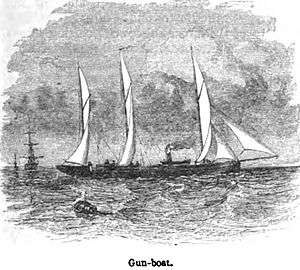Cheerful-class gunboat
 A typical 'Crimea gunboat' | |
| Class overview | |
|---|---|
| Name: | Cheerful class |
| Operators: |
|
| Preceded by: | Albacore class |
| Succeeded by: | Clown class |
| Built: | 1855 |
| In commission: | 1855 – 1869 |
| Completed: | 20 |
| General characteristics [1] | |
| Type: | 'Crimean' gunboat |
| Tons burthen: | 211 64⁄94 tons bm |
| Length: |
|
| Beam: | 21 ft 10 in (6.65 m) |
| Draught: | 6 ft 6 in (1.98 m) |
| Depth of hold: | 6 ft 7 in (2.01 m) |
| Installed power: |
|
| Propulsion: |
|
| Speed: | 6.5 kn (12.0 km/h) |
| Crew: | 30 |
| Armament: | 2 × 32-pounder SBML gun |
The Cheerful-class gunboat was a class of twenty gunboats built for the Royal Navy in 1855 for use in the Crimean War.[1]
Design
The Cheerful class was designed by W.H. Walker (who also designed the preceding Dapper and Albacore classes). The ships were of particularly shallow draft [Note 1] for coastal bombardment in the shallow waters of the Baltic and Black Sea during the Crimean War.[1]
Propulsion
One-cylinder horizontal direct-acting single-expansion steam engines built by John Penn and Sons, with two boilers, provided 20 nominal horsepower through a single screw, sufficient for 6.5 knots (12.0 km/h; 7.5 mph).[1]
Armament
Ships of the class were armed with two 32-pounder smooth bore muzzle loading cannons.[1]
Ships
| Name | Ship builder[1] | Launched[1] | Fate[1] |
|---|---|---|---|
| Cheerful | Deptford Dockyard | 6 October 1855 | Breaking completed at Haslar on 16 January 1869 |
| Chub | Sheerness Dockyard | 15 October 1855 | Breaking completed at Haslar on 29 January 1869 |
| Daisy | Thomas Westbrook, Blackwall | 20 March 1856 | Breaking completed at Haslar on 7 January 1869 |
| Dwarf | Thomas Westbrook, Blackwall | 8 April 1856 | Broken up at Haslar in 1863 |
| Blossom | John Laird, Sons & Company, Birkenhead | 21 April 1856 | Breaking completed at Haslar on 21 October 1864 |
| Gadfly | John Laird, Sons & Company, Birkenhead | 21 April 1856 | Broken up in November 1864 |
| Gnat | John Laird, Sons & Company, Birkenhead | 10 May 1856 | Broken up on 10 August 1864 |
| Garland | John Laird, Sons & Company, Birkenhead | 7 May 1856 | Broken up in June 1864 |
| Fidget | William Joyce, Greenwich | 7 April 1856 | Broken up at Haslar in 1863 |
| Flirt | William Joyce, Greenwich | 7 June 1856 | Breaking completed at Haslar on 30 April 1864 |
| Onyx | Young, Magnay & Company, Limehouse | 3 April 1856 | Dockyard craft (steam lump) 1869, sold in Jamaica on 8 July 1873 |
| Pert | Young, Magnay & Company, Limehouse | 3 April 1856 | Breaking completed on 12 March 1864 |
| Midge | Young, Magnay & Company, Limehouse | 8 May 1856 | Broken up in October 1864 |
| Tiny | Young, Magnay & Company, Limehouse | 8 May 1856 | Completed breaking at Plymouth on 28 January 1864 |
| Angler | Devonport Dockyard | 8 March 1856 | Breaking completed at Haslar on 21 January 1869 |
| Ant | Devonport Dockyard | 22 March 1856 | Breaking completed at Haslar on 23 February 1869 |
| Nettle | Pembroke Dockyard | 9 February 1856 | Broken up at Bermuda in October 1867 |
| Pet | Pembroke Dockyard | 9 February 1856 | Hulked 1865, renamed C17 from c.1900, sold to Castle for breaking on 12 April 1904 |
| Decoy | Pembroke Dockyard | 21 February 1856 | Breaking completed at Haslar on 8 February 1869 |
| Rambler | Pembroke Dockyard | 21 February 1856 | Breaking completed at Haslar on 7 January 1869 |
Notes
References
- Colledge, J. J.; Warlow, Ben (2006) [1969]. Ships of the Royal Navy: The Complete Record of all Fighting Ships of the Royal Navy (Rev. ed.). London: Chatham Publishing. ISBN 978-1-86176-281-8. OCLC 67375475.
- Winfield, Rif & Lyon, David (2004). The Sail and Steam Navy List: All the Ships of the Royal Navy 1815–1889. London: Chatham Publishing. ISBN 978-1-86176-032-6. OCLC 52620555.
This article is issued from Wikipedia - version of the 10/11/2015. The text is available under the Creative Commons Attribution/Share Alike but additional terms may apply for the media files.